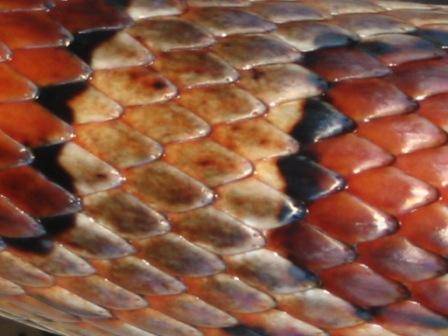
Coral Snake
Ancestory and Evolution
Body Structure
Eastern
Feeding
Reproduction
Western
Snake skin and scales

Snakeskin
Although snakes are covered with scales, part of their integument consists of skin. The skin of most snakes is impermeable to water, which prevents dehydration and is a vital factor in enabling them to live in arid desert regions. The dry skin is made up of three layers. The inner layer is the thickest and contains the pigment cells, the middle layer is very thin and consists of growing and dividing cells, and the tough outer layer comprises various types of plates or scales made up of dead cells. The skin is very elastic, and the scales stretch apart when the snake is swallowing and digesting large prey. When the snakes body is distended after a large meal, the intestinal skin can easily be seen, and indeed, it is the areas of skin between the scales that gives the snakes body its flexibility.
Permeability of the skin
Although scale may help to prevent dehydration, this may be a less important function. Why? Well it was discovered that desert snake species have a high resistance to desiccation, yet rainforest species do not. What is strange about it though, is that they both have similar arrangement of scales. This indicates that other mechanisms are of greater importance in this function.
Permeability of snakes is actually thought to be the true method of “anti-dry” in snakes. The skin attracts water which moves through the small canals between the granular scales. This forms a kind of water jacket, helping to prevent the snake from drying out.
The Scales
Reptile scales are formed from thickened area of epidermis. In this respect, they are unlike the scales of fishes, which can be removed individually without damaging the skin. All snakes are covered in scales but their shapes, textures, and arrangements very greatly. They fulfill several purposes. They form a good degree of physical protection from general wear and tear when the snake moves across rough surfaces etc. At the same time, the use of small units of amour allows great flexibility than would large bony plates and snakes depend heavily on flexibility during locomotion when subduing their prey. Elasticity is also important when swallowing. Certain scales are used in locomotion, when the edges are hooked over irregularities in the surface. The scales of most snakes also contain the cells that give the snake its characteristic color and markings, which are especially important in defense, such as camouflage and warning coloration.
Types of Scales
Snakes’ scales are not all the same type. There is variation between species and between different parts of the same species. There are oftentimes many specialized scales on the heads of snakes that help them to function better. In the elapids, the family that coral snakes belong to, large plate- like scales cover the head and are arranged in a more or less consistent pattern and are easily identifiable.

Coral snakes have smooth scales that cover their body, and make it easier for them to navigate through vegetation, loose sand, etc. Their polished surfaces produce less drag as compared to other types of scales. The scales covering the belly of all snakes are arranged in a single row, a feature that separates them from the lizards. These scales usually correspond to the position and number of ribs. The ventral scale immediately in front of the cloaca is known as the pre- anal scale and it may be single or divided, depending on the species. The scales beneath the tail may also be single or divided.